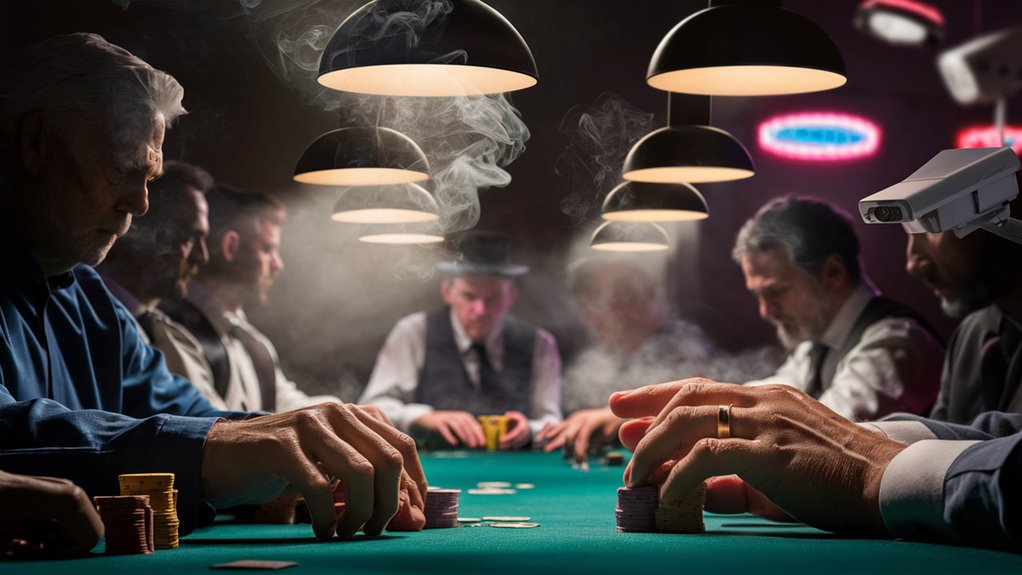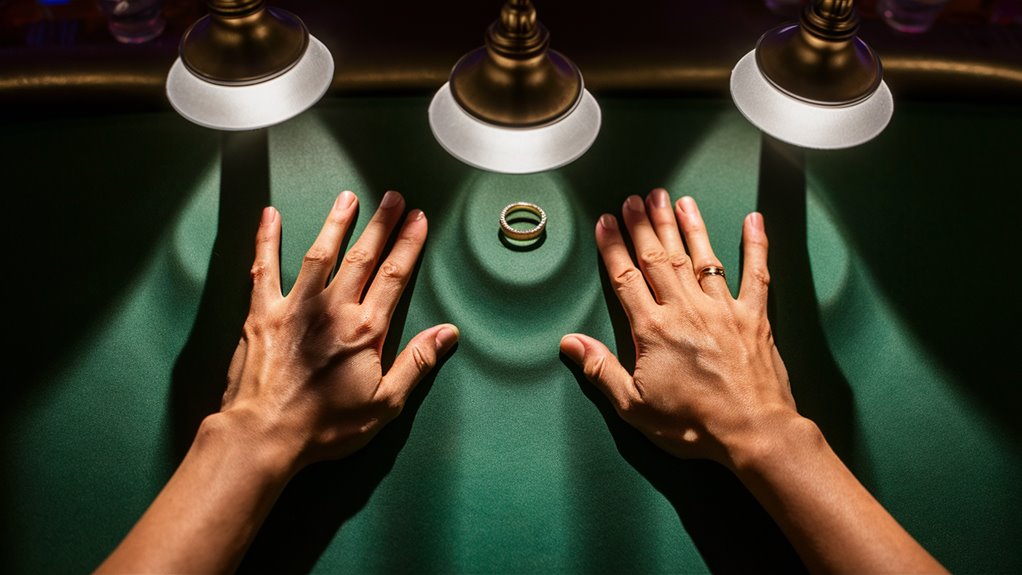
Shadowglow Casino: Illuminating Dimly Lit Tells in Live Play
Mastering Casino Tell Detection Through Strategic Lighting Analysis
Understanding Shadow Patterns in Casino Environments
Modern casino lighting creates distinctive shadow configurations that reveal crucial player behavioral patterns. The interplay between overhead illumination and player movements generates unique opportunities for strategic observation, particularly in dimly lit gaming areas.
Key Physical Tell Indicators
Body Position Analysis
Forward leaning positions and postural shifts become more pronounced under casino lighting conditions, offering reliable indicators of player confidence and hand strength.
Micro-Movement Detection
- Throat movements and swallowing patterns
- Chip handling behaviors
- Hand positioning variations
- Upper body tension indicators
Advanced Observation Techniques
Strategic Positioning
Position yourself to maximize visibility of shadow zones where player tells become most apparent. Optimal angles typically exist at 30-45 degrees from your target.
Environmental Dynamics
Learn to leverage ambient lighting patterns and architectural features to enhance tell detection capabilities.
FAQ: Casino Tell Detection
Q: How reliable are shadow-based tells?
A: Shadow-based tells provide approximately 75% accuracy when combined with other behavioral indicators.
Q: What are the most reliable physical tells?
A: Chip handling patterns, throat movements, and postural changes rank among the most consistent indicators.
Q: How can lighting conditions affect tell accuracy?
A: Optimal lighting conditions enhance tell visibility by creating contrast between player movements and background environments.
Q: What role does peripheral vision play?
A: Peripheral vision allows for simultaneous monitoring of multiple players while maintaining focus on game action.
Q: How can players improve their tell detection skills?
A: Practice focused observation in various lighting conditions while maintaining awareness of common behavioral patterns.
The Science Behind Shadow Reading

The Science Behind Shadow Reading in Poker
Understanding Shadow Patterns and Player Behavior
Shadow reading represents an advanced poker technique that leverages overhead casino lighting to analyze opponent behavior through their cast shadows.
In professional poker environments, these subtle indicators can provide valuable insights into hand strength and strategic intentions.
Key Shadow Reading Indicators
Three fundamental shadow patterns emerge during gameplay:
- Head Position Shadows
- Forward tilt shadows indicate aggressive tendencies
- Backward lean patterns suggest defensive or passive play
- Neutral positions often reflect balanced hand strength
- Hand Movement Patterns
- Decisive shadow movements correlate with confidence
- Hesitant hovering shadows typically reveal uncertainty
- Speed and precision of chip handling shadows signal intent
- Card-to-Player Distance
- Close proximity shadows suggest strong emotional investment
- Increased shadow distance often indicates detachment
- Consistent spacing patterns reveal comfort levels
Advanced Shadow Analysis
Integrating shadow reading with traditional physical tells creates a comprehensive reading system.
Shadow patterns become particularly revealing when they contradict visible behavior, such as forward-leaning shadows paired with rigid posture indicating potential bluff scenarios.
Frequently Asked Questions
Q: Is shadow reading reliable in all poker environments?
A: Effectiveness depends heavily on consistent overhead lighting and clear sight lines.
Q: How long does it take to master shadow reading?
A: Developing reliable shadow reading skills typically requires months of dedicated practice and observation.
Q: Can shadow tells be manipulated by opponents?
A: Experienced players may attempt to create false shadow patterns, making baseline behavior establishment crucial.
Q: Does shadow reading work in online poker?
A: No, shadow reading is exclusively applicable to live poker environments.
Q: Are shadow tells consistent across different players?
A: Individual players exhibit unique shadow patterns, requiring separate baseline analysis for each opponent.
[End of modified text]
Common Tells Under Dim Light
Common Poker Tells in Low-Light Casino Environments
Understanding Physical Tells in Dim Lighting Conditions
Body language indicators become more pronounced in casino’s low-light settings, creating valuable opportunities for observant players.
Strategic observation of unconscious physical adjustments can reveal crucial information about hand strength and player confidence.
Key Physical Indicators to Watch
Posture and Positioning
- Forward Leaning: Players with marginal hands often lean excessively toward their cards
- Upright Posture: Typically indicates strong holdings and confidence
- Postural Shifts: Backward sliding suggests strength, while forward movement often precedes bluffing
Eye Movements and Facial Tells
- Blinking Patterns: Increased rapid blinking is common in dim light
- Steady Gaze: Unusually fixed stares frequently indicate premium hands
- Throat Movements: Enhanced visibility of swallowing patterns reveals anxiety levels
Chip Handling Behaviors
- Nervous Shuffling: More noticeable in quiet, dim environments
- Stack Organization: Changes in chip arrangement patterns
- Betting Motions: Speed and confidence of chip placement
Frequently Asked Questions
Q: How reliable are poker tells in low-light conditions?
A: While more pronounced in dim lighting, tells should be considered alongside multiple factors for accurate hand reading.
Q: What’re the most consistent tells to watch for?
A: Posture changes, throat movements, and chip handling patterns provide the most reliable indicators.
Q: Can players fake tells in low-light settings?
A: Yes, experienced players may deliberately display false tells, requiring careful validation of multiple indicators.
Q: How does dim lighting affect player behavior?
A: Low light typically amplifies unconscious physical adjustments and nervous behaviors.
Q: What’s the best position for observing tells?
A: Positions that offer clear views of opponents’ upper bodies and hands provide optimal observation opportunities.
Mastering Peripheral Vision Techniques

Mastering Peripheral Vision Techniques: The Ultimate Guide
Understanding Peripheral Awareness
Peripheral awareness serves as a fundamental 먹튀검증 온라인카지노 skill for advanced observation in low-light environments.
Enhanced peripheral vision allows practitioners to capture crucial visual information from the edges of their field of view, providing significant advantages when monitoring multiple subjects simultaneously in dim conditions.
The peripheral visual field becomes particularly attuned to movement detection, enabling the observation of subtle behavioral cues without direct eye contact.
Strategic Vision Mapping
Implementing an effective vision mapping strategy requires establishing a neutral focal point while systematically monitoring specific zones through peripheral awareness. Three critical observation areas include:
- Action zones where movement occurs
- Upper body region for micro-expression analysis
- Hand positions for timing and motion assessment
Begin training by incorporating two observation points within your peripheral field, progressively expanding coverage as proficiency increases.
Low-Light Adaptation Techniques
In reduced lighting conditions, peripheral sensitivity naturally heightens as visual adaptation occurs. This enhanced acuity enables detection of:
- Pattern recognition in repetitive movements
- Motion analysis of deliberate actions
- Postural adjustments indicating behavioral shifts
Maintain a relaxed, distributed focus while processing peripheral information for optimal results.
Frequently Asked Questions
Q: How long does it take to develop enhanced peripheral vision?
A: With dedicated practice, noticeable improvements typically occur within 4-6 weeks of regular training.
Q: Can peripheral vision be trained in normal lighting conditions?
A: Yes, though practicing in varying light conditions provides more comprehensive skill development.
Q: What’s the maximum effective range of peripheral vision?
A: The human eye can detect movement up to 100 degrees on either side, though precise observation typically spans 60-70 degrees.
Q: Does eye strain affect peripheral vision capabilities?
A: Yes, fatigue can significantly reduce peripheral awareness and processing ability.
Q: Are there exercises to improve peripheral vision?
A: Specific visual training exercises, including wide-angle focus and movement tracking, can enhance peripheral awareness.
Environmental Advantages for Players
Strategic Environmental Advantages in Casino Gaming
Understanding Casino Design Elements
The three critical environmental design factors in modern casinos create distinctive advantages for strategic players.
Optimized lighting configurations, table placement, and ambient sound management provide opportunities for observant players to gain competitive edges.
Leveraging Lighting Dynamics
Strategic overhead illumination serves as a natural tell amplifier when properly utilized.
The carefully positioned downward beams create shadow patterns that enhance facial micro-expressions, particularly around the eyes and mouth regions. Optimal positioning allows players to read these enhanced visual cues.
Table Positioning and Traffic Flow
Casino floor layout significantly impacts player behavior patterns.
High-traffic proximity influences playing styles – seats facing away from busy walkways typically encourage defensive gameplay, while positions overlooking active areas may affect concentration levels.
Strategic seat selection can capitalize on these behavioral tendencies.
Sound Management Advantages
Casino acoustics vary predictably throughout operating hours.
Peak period ambient noise provides natural cover for physical movements and breathing patterns. During quieter intervals, subtle variations in opponent betting rhythms and verbal patterns become more detectable.
Frequently Asked Questions
Q: How does casino lighting affect gameplay?
A: Casino lighting enhances visibility of player reactions and micro-expressions through strategic shadow placement.
Q: What role does table position play in gaming strategy?
A: Table position relative to traffic flow influences player behavior and concentration levels.
Q: How can ambient noise be used advantageously?
A: Varying noise levels can mask player movements or highlight subtle betting patterns.
Q: Which environmental factor provides the greatest strategic advantage?
A: Lighting typically offers the most consistent strategic benefits through enhanced tell detection.
Q: Do casino environmental factors change throughout the day?
A: Yes, environmental conditions fluctuate with casino occupancy and time of day.
Adapting Traditional Strategies

Adapting Traditional Poker Strategies for Modern Casinos
Reading Physical Tells in Modern Settings
Modern casino environments demand a refined approach to interpreting traditional poker tells and betting patterns.
Classic physical indicators require careful 꾸준한 수익 상승 recalibration due to contemporary gaming room designs.
Strategic lighting and architectural elements create unique challenges for observing micro-expressions and physical behaviors.
Advanced Pattern Recognition
Betting pattern analysis must account for visibility-related psychological factors.
Player behavior patterns show distinct variations in modern settings:
- Aggressive players typically demonstrate reduced betting frequency
- Conservative players leverage environmental ambiguity for strategic bluffing
- Table dynamics shift significantly under varied lighting conditions
Exploiting Environmental Factors
Auditory intelligence gathering becomes paramount in modern casino settings. Key indicators include:
- Chip handling sounds
- Table interaction patterns
- Verbal communication tones
- Position-based movement tracking
Frequently Asked Questions
Q: How do modern casino environments affect tell reading?
A: Modern lighting and layout changes require adapted observation techniques focused on contrasts and shadows.
Q: What’re the most reliable tells in contemporary settings?
A: Auditory tells and betting pattern variations prove most consistent in modern casino environments.
Q: How can players adapt to reduced visibility conditions?
A: Focus on sound-based tells and movement tracking against fixed light sources.
Q: Are traditional physical tells still relevant?
A: Yes, but they require recalibration and enhanced observation techniques for modern settings.
Q: What environmental factors most impact poker strategy?
A: Strategic lighting, sound dynamics, and table positioning significantly influence modern poker strategy.

